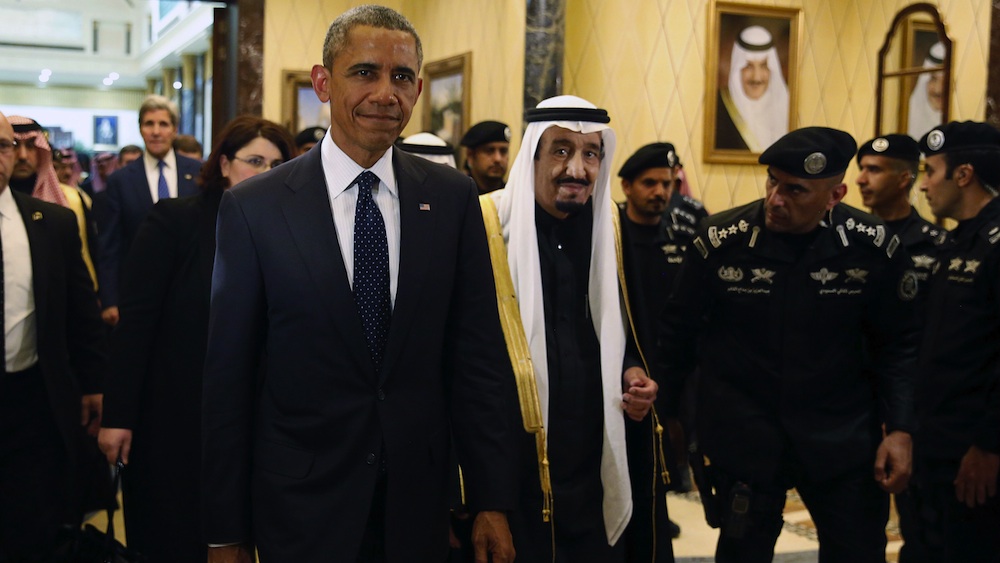Since July 2014 the price of oil has been falling, and a new OPEC strategy pushed through by Saudi oil minister Ali Al-Naimi makes a reversal unlikely in the near future. OPEC felt obliged to defend its market share against US fracking firms and other “marginal producers.” The pain felt in Moscow, Tehran, and Caracas is an unintended – if not unwelcome – byproduct.
Pin-pointing the reason for the dramatic – and continuing – fall in the price of oil is relatively easy: OPEC held its 166th conference in late-November 2014 to decide on a strategy to address oil prices, which had been falling at five to ten percent per month since July. Rather than pursue a production cut to boost prices as usual, OPEC adopted a Saudi proposal to keep output steady at 30 million barrels per day. The explicit intent of the Saudi strategy is to drive prices down until the highest-cost non-OPEC producers are forced from the market, with their shares reverting to the “most efficient producers” – that is, to OPEC.
For Russia, Iran, and Venezuela, this Saudi strategy is ruinous, so much so that many in these countries declare the whole affair a geopolitical plot hatched by the Saudis in league with the US and EU. However, while the impacts on Russia and Iran are certainly not unwelcome in Riyadh (or, for that matter, Washington or Brussels), Saudi oil minister Ali Al-Naimi – who was kept in place last week by Saudi’s new ruler King Salman, while most other high ranking ministers were reshuffled – insists that today’s new market realities had presented OPEC with no choice but to defend its market share in this manner. The pain imposed on Moscow, Tehran, and Caracas is but collateral damage to states already facing crises rooted in their politics.
The past decade of high oil prices, only temporarily interrupted by the Great Recession of 2008-09, enabled a plethora of small- and medium-sized US “fracking” firms, along with other marginal producers, to take significant market share. As long as prices remained high, this was not an existential difficulty for OPEC. However, when prices began to fall in mid-summer 2014, the impact was severe, especially for OPEC’s “price-hawk” faction. These are high-population OPEC states earning export-revenues-per-capita several times less than the Saudis and small Gulf OPEC states. In the run up to the OPEC conference, Venezuela, Iran, Algeria, Nigeria and other poorer, higher-population states were especially keen for OPEC to cut production to prop up prices. These price hawk states are, however, rarely willing to cut their own production; Libya, Iran, and Iraq all asked for and received hardship exemptions from having to cut in the event OPEC decided to do so.
Al-Naimi insisted that oversupply was so great that any cut would only be effective if non-OPEC producers joined in. The Venezuelan foreign minister, Rafael Ramirez, took the lead trying to satisfy Al-Naimi’s condition, and brought the Mexican and Russian oil ministers to meet Al-Naimi in Vienna before the OPEC conclave began there. Al-Naimi related what the Russian oil minister then offered: “In the end, he said he could not make any reductions because their wells are old, and if they reduce, the wells will not come back up … We said ‘thank you’ and the meeting was over. So too, the Mexican minister explained his country’s difficulties.”
With both OPEC and non-OPEC producers unable to cut production, the OPEC conference agreed there was no choice but to maintain production until falling prices force sufficient numbers of high-cost producers from the market.
From mid-2014, a veritable “perfect storm” of market factors capable of depressing prices was gathering such that, had OPEC alone cut production and pushed prices up, it would have just given market share to American shale-oil producers.
On the demand side, the main driver of the past decade was Asian economic growth. While Asian demand will generally expand, its rate is slowing. In 2014, China experienced its lowest growth, 7.4 percent, in 24 years. The EU has also gotten itself into a low-growth, perhaps-deflationary mode. And as for Latin America, with growth dependent on commodity exports, China and the EU’s situation augers protracted low growth. And even though the American economy is in recovery, its oil-use profile was transformed in recent years, with long-term oil demand plateauing.
On the supply side, since 2006 the United States has produced more new oil due to hydraulic fracturing technology than all the production removed from the market in Libya, Iraq, Iran, and other Middle East and North African (MENA) states due to conflicts and sanctions. However, protracted high prices enabled other marginal producers, including those in Canadian developing Alberta’s previously uneconomic “tar sands” extra-heavy oil; Brazil’s national oil company, Petrobras, which developed new, deep-offshore “sub-salt” fields; and West-African states that developed new high-price-tag offshore projects. And, had prices remained high and Russia unsanctioned, complex and costly Arctic projects with western firms’ know-how were on the agenda to compensate for Western Siberia’s decline.
But it is not only a matter of market fundamentals that brought prices down. In the futures market, the huge, speculation-driven price boosts seen before the Great Recession did not reoccur in mid-to-late 2014, even as ISIS advanced dramatically in Iraq, Libya’s civil war flared, and Russian Arctic projects were undermined by sanctions, because new US laws restricting pure speculation in the futures market were now in place.
Although implications for Russia, Iran, and Venezuela are very negative, this is not because the Saudis, the US or EU took aim at them. While their plights do derive in part from political decisions taken by their leaders, the harsh reality is that, even if those decisions were now reversed – and they are unlikely to be – the trajectories of their outdated and poorly managed oil-sectors, increasingly uncompetitive in the “big leagues” of today’s high-tech and higher-efficiency marketplace, would take longer to correct.







